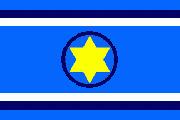Judea
| Conventional short name: | |
| Local: | יהודה Jhuda |
| English: | Judea |

| |
Judea is a country in the Middle East.
History
A Short History of Judea, From the Point of Divergence:
The *here* and *there* histories of Judea diverge after the Bar Kokhba Revolt of 132-135 CE. *Here*, the Roman Emperor, Hadrian, made decrees against Judaism, rebuilt Jerusalem as a Roman city "Aelia Capitolina", exiled and/or sold into slavery much of the population, and renamed the country "(Syria) Palestina". The Hadrianic persecutions lasted until 138 CE.
*There*, on the other hand, Hadrian took a different approach. He gathered soldiers and civilians from all over the Empire (but most of them were from one area), and swamped Judea with imperial colonists. He didn't mind if there was still a province of the Empire named Judea, and a city named Jerusalem, but he wanted to de-Judaize the country. Only colonists were allowed to hold government offices or any other kind of power, and both Hebrew and Aramaic were discouraged.
However, his plan backfired, as over the following centuries, even though Judea was still part of the Roman Empire, the colonists for the most part 'went native'. Their only victory was the slow replacement of Hebrew and Aramaic by Romance; however, this proceeded so slowly that the form of Romance spoken in Judea became heavily influenced by the Semitic language environment, imitating Hebrew in many phonological and grammatical ways. Although originally rejected as the hated 'Soldier-Speak', the language known for most of its history as Ittalcit ("Italian") eventually became the vernacular of the majority of the population.
And then the Islamic Empire (late 7th century) burst out of Arabia and swept across the Middle-East. Roman Judea fell, and came under the islamicizing and arabicizing influences. This lasted for a few hundred years, until the Islamic Empire began to break up into rival caliphates. In the confusion, Judea declared its independence, and the Third Jewish Commonwealth began.
Unfortunately, just as they had gained control of enough territory to make Judea a viable state, in the 11th century CE the Crusaders came sailing in from the Mediterranean, and set about Liberating The Holy Land From The Infidels. Caught between 'Edom' and 'Ishmael', Judea - even though its military was greatly enhanced by refugees from the falling Khazaria - couldn't maintain its independence. The crusaders, like *here*, waded knee-deep in blood as they sacked Jerusalem.
Those who survived escaped into the deserts and mountains, and fought a guerrilla war against both the Crusaders and Arabs (commonly playing one side against the other) that lasted almost 500 years. Eventually, some time in the 16th century, the Judeans finally kicked out the European Crusader forces, while keeping the caliphates from rushing in to take their place. The Fourth Jewish Commonwealth was inaugurated, and began secret political relations and trade with Mueva Sefarad in North America (since MS hadn't yet revealed itself).
When the Ottomans conquered the Middle East and much of the Balkans, the Fourth Commonwealth allied itself with the mostly Druze nation of Lebanon and successfully repelled the Turks from most of the Levant. This lasted until the mid-1800s, when the Ottoman Empire conquered Judea and Lebanon. Armed resistance was fierce, but neither nation resorted to protracted guerrilla warfare when in the years after the conquest they saw that the Ottoman Turks weren't interested in religious persecution or ethnic assimilation, just empire-building. This lasted until a few years after the First Great War, around 1922, as the separatist movements in the Ottoman Empire spread southeastwards from the Balkans into the Mideast. Thus, the Fifth Commonwealth began.
In the Second Great War Judea fought on the allied side and dispatched its soldiers to fight Ethiopian forces in Egypt.
Culture
Religion
Population: 10,321,540
- 72.5% Jewish =7,483,117
- 92.43% Rabbinic=6,916,645
- 5.47% Samaritan=409,327
- 2.1% Karaite=157,145
- 9.62% Christian=992,932
- 64.8% Eastern Orthodox=545,738
- 17% Catholic=143,180
- Latin=79,332
- Maronite=36,888
- Armenian=4,182
- H.R.E.L.=3,656
- 11% Oriental Orthodox=92,646
- Syriac=57,952+2,520=60,472
- Armenian=10,320+2,518=12,838
- Ethiopian=9,750+2,518=12,268
- Coptic=4,550+2,518=7,068
- 06% Church of the East=50,534
- 01.2% Protestant=10,140
- Lutheran=8,422
- Temple Society (Templers)=1,718
- 9.45% Muslim=975,386
- 86% Shafi’i & Hanafi Sunni=838,832
- 14% Shia=136,554
- Athna'ishari=124,548
- Alawiyya=12,006
- 5.43% Druze=560,460
- 3% other (inc. non-religious)=309,645
Geography
Borders
North: Lebanon.
West: Mediterranean Sea.
Southwest: Egypt.
Southeast: Hijaaz.
East: Bedouin Free State.
Northeast: Syria.
See also
See also: Judajca
An Incomplete List of Middle-Eastern Countries in IB, c.2002:
- Judea (Commonwealth of Judea)
- Lebanon (Lebanese Union)
- Hijaaz (Hashemite Kingdom of the Hijaaz)
- United Arab Emirates (includes Bahrain and Qatar)
- Kuwayt (Shaykhdom of Kuwayt)
- Kurdistan
- Turkey (Republic of Turkey)
- Armenia
- Azerbaijan
- ‘Iraaq
- Syria
- Yemen
- Egypt
- Sa‘udi ‘Arabia
- Al-Basra (Ecotopic Arab Republic of Al-Basra)
Relationships and Info:
Judea and Lebanon are allies; both have more-or-less friendly relations with Syria. Periodically, tensions flare up because of arguments over the water resources of the mountain regions at their borders. The Hijaaz is constantly in conflict with Sa‘udi ‘Arabia, which wants to 'purify' Mecca and Medina and impose Wahhabi Islam on them. Armenia is substantially bigger than it is *here*, and includes much of what is *here* northeastern Turkey. Southeastern Turkey is part of Kurdistan. Al-Basra began in the aftermath of the 1991 war when ‘Iraaq tried to conquer Kuwayt. A coalition of regional powers, as well as other nations interested in the stability of the oil trade, drove the ‘Iraaqi forces north out of Kuwayt, causing heavy damage to the formerly bustling marsh region around the port of Basra City in the process. After the war, with ‘Iraaq's military power broken, the people of Basra City and the southern marshlands near Kuwayt and the Gulf seceded. The leaders of the revolution put forth a platform of protecting the environment, including weaning the area's economy and lifestyle away from dependence on fossil fuels (because of the ecological damage inflicted by the wrecked oil fields of the area in the war).
JEWISH DIASPORA
There is a Jewish Diaspora *there*, and Mueva Sefarad is part of it. After all, the diaspora did not start with the Hadrianic Persecutions; there was already a diaspora during the Second Temple/Second Commonwealth period. There is still a diaspora in Ill Bethisad; just because there was a stronger, continuous Jewish presence in Judea doesn't mean that everyone lived there, or that it was a nice place to be. After all, the Judeans were hiding out in caves, fighting for their lives during a Crusader period that lasted *500* years!
MUEVA SEFARAD
Which brings us to Mueva Sefarad. Mueva Sefarad ("New Spain" in Judeo-Spanish) is a province of the North American League on what is *here* Newfoundland Island and the southeastern corner of Labrador. It was originally settled by Jewish refugees from the Spanish Expulsion of 1492. Later they were joined by Spanish Muslims, Anusim ("Marranos", Crypto-Jews) and their Muslim equivalent, as well as sincere "New Christians" who no matter how hard they tried weren't accepted into Iberian society. Then, in the 20th century immigrants from other parts of the world started coming also.
But the reason why the Sefardim sailed off into the wild unknowns of the North Atlantic was because they couldn't go east across the Mediterranean to Italy, Turkey, the Levant, etc., like they did *here* - because *there* the Crusades were still going on, and it wasn't safe for them.
Where Jordan is *here*, over *there* is taken up by a few different countries. The western part of Jordan is part of Judea. The northeastern part is split between Syria and Iraq. The southeastern area is part of the Bedouin Free State, an amorphous sort of zone with no real centralized government that is bounded on the west by the Red Sea and Judea, the southwest by Hijaaz, the south by Saudi Arabia, the east by Basra, and the north by Iraq and Syria.
WESTERN ASIA
According to what I posted about the Middle East, Armenia is an independent country substantially larger than it is *here*, including much of what *here* is north-eastern Turkey. If you have no objections to that, Azerbaijan and Georgia could still be part of Russia even if Armenia is not; or they could have recently asserted their independence, like *here*. The Central Asian borders, as far as I know, have not been set yet; although I am assuming that Iran and Afghanistan look roughly the same *there* as they do *here*.
[What about if Russia conquered the whole area during its early-1900's fighting with the Ottoman Empire; then, after the fall of the SNOR, Armenia, Georgia, and Azerbaijan formed some kind of "Caucasus Federation" (which it looks like they tried to do for a little bit *here* in the early 20th century). Or, the Ottomans could conquer the whole area, start the Armenian Genocide, but then the Armenians fight back, declaring their independence and sending another set of nationalist ripples through the Empire, helping it break up in the 1920's. Maybe that is when they start a Caucasian Federation, except *there* it works and they keep out both the Turks and the Russians.]




